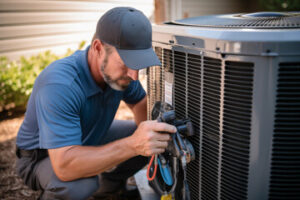If your air conditioning unit is over ten years old and you’re constantly having to pay for AC repairs, a replacement may be in order.

Newer units use new types of refrigerants that don’t contain ozone-depleting chlorofluorocarbons (CFCs) or hydrofluorocarbons (HCFCs). Newer models also tend to be more energy efficient, so they can help you save on your utility bills.
Depending on the type and size of air conditioning unit and the SEER rating, the cost to replace an air conditioner can range from around $3,800 to $8,000. The HVAC company that you choose can help you evaluate your options and make recommendations.
A new AC system is much more energy efficient than those produced even 10 years ago. This is due to a combination of factors, including advances in technology and a move away from the old ozone-depleting chlorofluorocarbon refrigerant. In addition, many manufacturers now offer ENERGY STAR® systems, which are designed to meet or exceed the federal energy efficiency standards. The result is lower energy bills and a better environment.
Another factor that should be considered is the age of your current system. Air conditioners have a lifespan of around 15 to 20 years, and it’s important to consider how long you plan on staying in your home when making a replacement decision. If you plan to move out in a few years, it may be more cost effective to repair your current system and save the replacement for when you sell the house.
If you decide to replace your existing air conditioner, the installation costs will include removing and disposing of the old unit. In some cases, this can be included in the purchase price or at an additional cost. It is also essential that your new equipment is matched with the proper ductwork to ensure it will operate properly.
In addition, you should check with your local building department to see what is required for permits and fees for HVAC replacement. Generally, these will be included in your total project cost and are usually transferable to the next homeowner if you decide to sell. Another consideration is if you will qualify for any rebates or tax credits to offset the cost of your new air conditioning system. These are a great way to bring the overall cost down significantly. A knowledgeable professional can provide all the information you need on rebates and incentives for replacing your air conditioning system.
Energy Efficiency
A new air conditioner that is more energy efficient than your older unit will help to lower cooling costs. A new AC system that is ENERGY STAR certified will have an efficiency rating of at least 14.5 SEER or higher. In addition to saving money on monthly electricity bills, a more efficient air conditioning unit will also reduce the need for frequent repairs, prolonging its lifespan.
An air conditioning replacement can help to save money on energy costs, a benefit that may offset the cost of a new unit. If your home’s electric bill has been steadily rising over the past few years, it is a good idea to check on the energy efficiency of your AC system.
In recent years, there has been a great deal of advancement in air conditioner technology, making these systems more energy efficient than ever before. It is a good idea to purchase a new air conditioner with a high SEER rating, especially if your current unit has been in service for more than a decade.
Many utility companies offer energy rebates for upgrading to an energy-efficient AC unit. These can significantly lower the upfront cost of a new system and make it easier to afford.
A new air conditioning unit that is more efficient will use less energy, reducing carbon emissions and the environmental impact of your home. It is important to consider the effect your AC system has on the environment when deciding whether to repair or replace it.
Energy-efficient systems are designed to operate as a set, with an indoor and outdoor unit working together to cool your home. A mismatched system will be inefficient, wasting energy and possibly damaging both units. It’s a good idea to consult a professional contractor about the best options for your home.
Replacing your old air conditioning system can provide numerous benefits, including reduced energy costs, a healthier environment, and increased comfort. A professional can help you select a new air conditioner with the right size and features for your home and budget. They will also show you how to operate and maintain the system for maximum efficiency and performance.
Efficiency Rating
When shopping for a new air conditioning system, you’ll want to consider its efficiency rating. This number indicates how efficient it is at cooling your home, and it will be an important factor in determining how much it will cost to maintain your system over the years. Having an air conditioner with a high efficiency rating can help you save on energy bills and reduce your carbon footprint.
Air conditioning efficiency ratings are determined using a number of factors. The most common is SEER, or Seasonal Energy Efficiency Ratio. This rating measures how much cooling it is able to provide for a given amount of energy consumed by the system over an entire season. It is comparable to a car’s gas mileage rating. SEER ratings begin at around 8 and go up from there, with the most efficient whole-home systems having SEER ratings in the 20-25 range.
There is a new standard called SEER2 that has recently replaced the older SEER rating. While SEER and SEER2 have the same minimum rating, SEER2 uses a different testing process to more accurately reflect real-world performance.
Another efficiency measure is EER, or Energy Efficiency Ratio. This rating is similar to SEER, but it looks at how well an AC performs in non-steady conditions rather than a single test with set temperatures and humidity levels. EER is more useful for Sacramento and Folsom residents, as it gives a better sense of how an AC will work at peak temperatures.
There’s also the Coefficient of Performance (COP), which is a measurement of how much heat an air conditioner can remove for every unit of energy it consumes. Unlike SEER and EER, which are based on a single unit of time, COP is more relevant to how long an air conditioner will be running in a specific climate.
As you shop for an air conditioning replacement, remember that these efficiency ratings are only a snapshot of how well the system will operate. Things like dust and lack of routine maintenance will affect its performance over the years, and will cause it to use more energy than needed. A qualified HVAC technician can advise you about ways to optimize your home for maximum efficiency, and can make sure the new system you choose is matched to your indoor and outdoor units so they can work as a team.
Warranty
When choosing a replacement air conditioner, be sure to understand the warranty terms. Comprehensive warranties typically cover critical AC components such as compressors and coils. However, they usually exclude labor costs for part replacement and routine wear and tear. For additional peace of mind, consider an extended parts and labor warranty option.
A good warranty from a manufacturer may last for up to 10 years on a new air conditioning system. However, it’s important to register your system in a timely manner. Manufacturers often check maintenance history during any repair or replacement claim, and a lack of proper registration can void the warranty. This is why it’s important to choose a company that files warranties online and in-house. Terry’s A/C and Heating does this on-site as a part of every service call.
Depending on the equipment manufacturer, warranties can also be transferable between homeowners. This requires the prior owner to have registered the equipment and paid a transfer fee within a specific timeframe. If you plan to sell your home in the future, this option can add value to your house and save you money on repair costs in the interim.
When considering the cost of a replacement air conditioning system, it’s worth investigating any potential rebates or tax credits that could help offset the initial investment. This will give you a sense of the initial return on your investment and will provide further motivation to move forward with the project.
Finally, consider your home ownership goals when making an AC replacement decision. If you’re planning to sell your home in the near future, an older AC unit with a poor track record can have a negative impact on your home’s resale value. A new AC installation can improve your home’s resale appeal and potentially reduce the time you spend looking for a buyer.
Be sure to research the various manufacturers of air conditioning units and compare their warranties. Then, find an HVAC company with a good reputation that offers competitive pricing and a solid warranty. This will ensure you’re getting the best possible quality and performance from your new air conditioning system.
